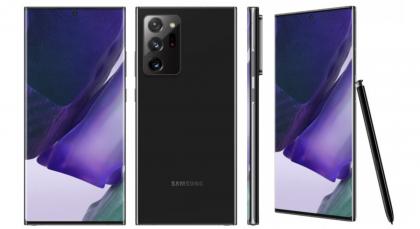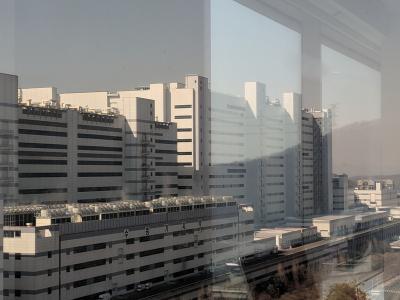OLED Smartphones - introduction and industry news - Page 22
Samsung announces a new variable refresh rate technology for its latest AMOLED displays
Samsung Display announced a new OLED technology, called Adaptive Frequency that enables variable refresh rate in AMOLED displays - ranging from 10Hz to 120Hz. Running OLEDs at low refresh rates when possible can reduce the power consumption of the display (over all applications) by up to 22%.

This new display technology was applied for the first time in the Galaxy Note20 Ultra 5G smartphone, announced earlier this month, with its 6.9-inch 1440x3088 Dynamic AMOLED.
Samsung launches several new AMOLED devices, including the Note 20 and the Galaxy Z Fold 2
Samsung announced several new OLED devices yesterday. We'll start with the new Galaxy Note 20 which sports a 6.7-inch 1080x2400 HDR10+ Super AMOLED Plus display (which could mean this is an RGB display, not a Pentile one). The Galaxy Note 20 Ultra has a larger 6.9-inch 1440x3088 Dynamic AMOLED. The display supports a refresh rate of 120Hz at Full-HD resolution and 60Hz at QHD. According to the Elec in Korea, the Note 20 Ultra display has an LTPO backplane (which Samsung calls HOP).

Next up is the company's 2nd generation Galaxy Z Fold 2 that is an update to the original fold with a larger internal foldable display at 7.6" 1768x2208 HDR10+ 120Hz Dynamic AMOLED and also a larger 6.23" 816x2260 Super AMOLED cover display. The Fold 2 also improves the hinge design and sports an ultra-thin-glass cover (like the Galaxy Z Flip).
Samsung reports its Q2 2020 financial results, sees full-fledged mobile display recovery only in Q4 2020
Samsung reports a large increase in its profit in Q2 2020 - as the COVID 19 pandemic increases demand for memory chips, and also as a result of a one-time $950 million penalty payment from Apple following lower OLED orders.

Samsung's net profit in Q2 2020 totaled $4.67 billion (an increase of 7% from Q2 2019), while its revenues were $44.4 billion (down 6% from last year).
LGD reports its financial results for Q3 2020, with lower demand for OLED TVs and pOLEDs
LG Display reported its financial results for Q2 2020 - with revenues up 12% over last quarter, as the company enjoyed an increase in demand for IT panels (monitors, notebooks, tablets). But lower demand for TVs and lower utilization at its POLED fabs increased LGD's operating loss.

LG Display says it expects its Q3 revenues and operation profit to improve - as mass production of OLED TV panels in Guangzhou finally started, and the company will ship pOLED panels to Apple's iPhone 12 in the next quarter. LG maintains its 4.5-5 million OLED TV panel shipment forecast for the whole of 2020.
BOE to start producing on-cell touch OLED panels, to supply to Huawei's Mate 40 flagship
According to a report from Korea, BOE will start producing AMOLED displays with on-cell touch, and ship the first such panels to Huawei to be used in its Mate 40 flagship smartphone. The Mate 40 is expected by October 2020, and BOE will start producing these panels soon.

Huawei Mate 30 Pro
BOE is not the only OLED maker to supply to Huawei's Mate 40 series - Korea's Samsung and LG Display will also ship similar panels to Huawei, some of these will use on-cell touch and some will use add-on touch panels, this depends on the Mate 40 model.
JDI developed a new OLED production technology, looking for customer partners to commence mass production
Japan Display says it is developing a new OLED production technology that will enable higher resolution and higher efficiency OLED displays, and the company is in talks with potential customers regarding a joint investment in producing next-generation OLEDs.

According to JDI's CEO, the company is using a new manufacturing technology that is different to the evaporation method currently used by OLED makers. It is not clear what is meant by that - it could be an inkjet-printing technology (but achieving high resolution for smartphone displays with inkjet printing is a challenge) or something like OVPD or OVJP - or a new technology developed in-house at JDI.
Omdia now sees the OLED market contracting 1.2% in 2020
Omdia (IHS Markit) updated its forecast for the 2020 OLED market - and the company now sees the market contracting 1.2%, to 465 million panels, as demand for high-end smartphones is falling.
In April 2020, Omdia saw an increase of 9% in demand for OLEDs - 512 million panels, up from 471 in 2019, even though it already forecasted a fall in demand for smartphone.
DSCC: Samsung received around $950 million from Apple due to lower OLED panel orders
DSCC estimates that Apple paid around $950 million to Samsung Display in the last quarter - due to lower smartphone OLED orders. Apple is committed to buy a certain amount of displays, and this payment is a fine due to lower orders.

A year ago in July 2019, Apple paid $684 million - again as compensation for lower-than-agreen-on iPhone OLED panel orders.
Reports suggest Visionox started to ship AMOLED displays with an under-the-display camera to Huawei and Xiaomi
Last month Chinese OLED producer Visionox launched an under-the-OLED camera technology, branded as InV See - which enables a selfie camera in a full-screen OLED smartphone. According to new report from China, Visionox has already shipped InV See displays to Huawei and Xiaomi which will launch smartphones with these displays soon.
The report suggests that Visionox started to ship these displays in the second half of 2019 - and these deals were worth over 3.5 billion yuan (around $500 million USD).
UBI sees fast growth in Polyimide films and ultra-thin glass for foldable smartphone displays
UBI Research estimates that foldable smartphone display makers will continue to rely on both Ultra-Thin-Glass (UTG) and Colorless Polyimide (CPI) films for at least the next five years.

UBI sees demand for CPI films will reach 4.3 million units in 2020 while demand for UTG will reach 3.5 million units. Demand for both products will grow and by 2024 it will reach 37.1 million units for CPI and 30.5 million for UTG.
Pagination
- Previous page
- Page 22
- Next page

